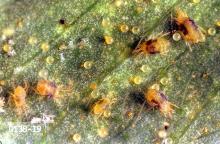Includes spider mite (Tetranychus urticae)
Pest description and crop damage Spider mite adults are small, eight-legged, spiderlike animals associated with webbing and round eggs on the underside of leaves. They are pale green, yellowish to reddish, with two large, dark spots on each side of their bodies. They suck plant juices, causing leaves to yellow, dry, and fall under heavy infestations. They reduce oil yield and probably quality.
Biology and life history Mites overwinter as mature females found at the bases of mint stems and underground. In spring, feeding begins on new growth soon after emergence from soil. Populations are delayed a few weeks in fields flamed for rust in the spring. Females lay eggs associated with silk webbing. Egg to adult may take as little as 14 days during the hot part of summer. There are multiple generations each year.
Scouting and thresholds Average numbers of mites per leaf are determined throughout a field on a weekly basis. Take 45 leaf samples (three leaves per stem, 15 stems per site), and use the presence or absence of mites on leaves to estimate a mean number of mites per leaf at a site in a field. Stable and increasing populations of spider mites beginning at levels of five mites per leaf can reduce oil yields if not controlled.
Management-cultural control
Fall plowing and fall and spring flaming tend to delay spider mite buildup early in the season. These practices can also reduce predator populations whose absence sometimes allows for a more rapid spider mite population build-up in the spring than would otherwise occur.
Management-biological control
Predator mites naturally occurring in the field as well as those bought from suppliers and released into fields early in the season before spider mites reach damaging levels can maintain spider mite levels sufficiently low to avoid miticide applications. This assumes that production practices that reduce predator mites can be avoided or timed so as to reduce their negative effects.
Management-chemical control
- abamectin (ABBA, Agri-Mek SC, Reaper) at 0.0096 to 0.014 lb ai/A. PHI 28 days. REI 12 hr. Retreatment interval 7 days. Do not exceed 0.042 lb ai/A per season, apply more than twice consecutively or make more than three applications per year. Apply in at least 20 gal water/A (ground) or 5 gal water/A (aerial). Do not allow livestock to graze or feed treated foliage to livestock. To avoid illegal residues, Agri-Mek SC must be mixed with a non-ionic activator type wetting, spreading and/or penetrating spray adjuvant. Restricted use pesticide.
- bifenazate (Acramite 4SC) at 0.375 to 0.75 lb ai/A. PHI 7 days. REI 12 hr. One application per year only. Apply by chemigation in 0.1 to 0.2 acre-inches of water.
- Burkholderia spp. (Venerate XC) at 2 to 4 quarts/A. PHI 0 days. REI 4 hr. Suppression only. OMRI-listed for organic use.
- Chromobacterium subtsugae (Grandevo) at 0.6 to 0.9 lb ai/A. PHI 0 days. REI 4 hr. May be applied by chemigation. Apply in at least 10 gal water/A. OMRI-listed for organic use.
- etoxazole (Zeal) at 0.09 to 0.18 lb ai/A. PHI 7 days. REI 12 hr. Do not exceed 0.18 lb ai/A per season or make more than one application per season. Apply in at least 50 gal of water/A (ground) and 10 gal/A (air). Do not use below use rate 2.0 oz/A (0.09 lb ai/A) as this may result in poor control and contribute to the development of resistance to etoxazole among mite populations.
- fenazaquin (Magister SC) at 0.3 to 0.48 lb ai/A. PHI 7 days. REI 12 hr. Do not exceed application rate of 36 fl oz of product (0.48 lb ai/A) per year or make more than one application per year. Apply in at least 20 gal water per acre. Apply this product before bloom.
- fenpyroximate (FujiMite) at 0.053 to 0.105 lb ai/A. PHI 1 day. REI 12 hr. Retreatment interval 7 days. Do not apply more than 0.2 lb ai/A per growing season or 2 applications. Apply in at least 25 gal water/A. Do not apply through any type of irrigation system. Do not apply through any type of irrigation system.
- hexythiazox (Onager Optek) at 0.094 to 0.156 ai/A. PHI 30 days. REI 12 hr. One application per year. Check SLN label for minimum water volume. SLN OR-170009; ID-170003; WA-170005.
- malathion (Gowan Malathion 8) at 0.94 lb ai/A. PHI 7 days. REI 12 hr. Retreatment interval 7 days. Do not exceed 3 applications and 2.82 lb ai/a per year.
- propargite (Omite 6E, Comite) at 1.5 to 2.0 lb ai/A. PHI 14 days. REI 7 days. Retreatment interval 7 days. Do not exceed 4.1 lb ai/A or two applications per year. Apply in at least 20 gal water/A. Do not feed treated mint to livestock. Restricted use.
- spiromesifen (Oberon) at 0.125 to 0.25 lb ai/A. PHI 7 days. REI 12 hr. Retreatment interval 7 days. Do not apply more than 3 times per season and do not exceed 0.75 lb ai/A per season. Apply in at least 10 gal water/A (ground) or 5 gal water/A (aerial). Do not apply while mint is in flower. Do not apply when bees are foraging on mint. SLN OR-200013; WA-170012.
Note: Use of carbamate and some OP insecticides may stimulate or increase spider mite populations by killing predator mites or even stimulating spider mite reproduction. Certain miticides, even though they initially control spider mites, may result in a subsequent rapid increase in numbers due to the effect on predator mites that contribute to biological control.


